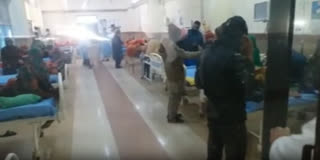Three in every 1,000 people have active TB in country: Parliamentary panel report
“TB occurs in every part of the country. As per India TB Report 2023, the TB case notification in 2022 is 24.2 lakh cases, translating to a case notification rate of approximately 172 patients per lakh population. Delhi recorded the highest case notification rate among States (546 per lakh population),” the report said.


Published : Sep 22, 2023, 8:00 PM IST
New Delhi: Asserting that three in every 1,000 people have active Tuberculosis (TB) in India, who are actively transmitting the disease, a Parliamentary Committee on Health and Family in its latest report has stated that Delhi accounts for the highest burden of TB cases compared to other states and Gujarat has the lowest TB prevalence in the country.
The Committee headed by Rajya Sabha MP Bhbubaneswar Kalita in its 149th report that was tabled in Parliament on Thursday has also identified several reasons for the rapid increase of TB cases in the country. The report has identified that a huge and dense population with a need for more infrastructure, rapid urbanisation with poorly built environments, including hazards in the workplace, poor ventilation and overcrowded homes, poor nutrition and low socio-economic status of large segments of the population are some of the reasons for the increase of TB cases.
It has also been said that unhygienic practices like spitting in public places and noncompliance with respiratory and cough hygiene, smoking, alcoholism, diabetes and drug addiction, high incidence of anaemia and malnutrition, low vitamin D levels in the Indian population, older people with a history of TB and chronic respiratory disease are also other major causes for TB.
“TB occurs in every part of the country. As per India TB Report 2023, the TB case notification in 2022 is 24.2 lakh cases, translating to a case notification rate of approximately 172 patients per lakh population. Delhi recorded the highest case notification rate among States (546 per lakh population),” the report said.
Haryana, Chhattisgarh, Rajasthan and Uttar Pradesh are the four other States having a large prevalence of TB. India continues to be the most significant contributor to global TB incidence. India contributes approximately one-fourth of the international cases, roughly 25 lakhs out of 1.05 crore globally.
As reported by the WHO Global TB Report 2022, eight out of 30 countries with the highest TB burden countries account for more than 2/3rd of the global TB burden and among those eight countries, India’s share is 28 per cent. Quoting information provided by the Ministry of Health & Family Welfare, the Parliamentary Committee report said the last five years' trend of TB notifications for all forms of TB in India across all States and UTs, both in the public and private sectors, shows that there is an increase in notification rate during 2022 as seen in the states of Uttar Pradesh, Maharashtra, Madhya Pradesh, Bihar and Goa.
It is also noted that the total number of TB case notifications in the last five years suggests that the top seven states account for more than 60 per cent of the TB burden in India. Since 2020, the UT of Daman & Diu has also shown an upward trend in TB notifications.
To identify the geographical locations of high TB burden in the country, the Health Ministry data was further categorised into region-wise TB notification cases including Northern States (Uttar Pradesh, Rajasthan, Jammu & Kashmir, Punjab, Uttarakhand, Haryana, Himachal Pradesh, Chandigarh, Delhi); Southern States (Tamil Nadu, Andhra Pradesh, Telangana, Karnataka, Puducherry and Kerala); Central States (Madhya Pradesh & Chattisgarh), North-eastern States (Assam, Mizoram, Manipur, Sikkim, Nagaland, Arunachal Pradesh & Meghalaya), Western States (Maharashtra, Goa, Gujarat, Daman & Diu, Dadar & Nagar Haveli) And Eastern States (Bihar, Jharkhand, West Bengal & Odisha).
While analysing the data, it is found that northern region states are the highest contributing areas in TB disease burden, followed by the western region states. The percentage distribution of TB case notifications across geographical regions of the country reflects the highest percentage of northern states. There was a reduction in reporting of TB cases during 2020-21, however, the TB cases started getting notified in post-pandemic times.
“Since TB is more prevalent in crowded areas, northern states like Uttar Pradesh, being a highly populated state, are likely to contribute highly to the TB burden in India,” the report stated. As per India TB Report 2023, diagnosing TB among children is comparatively more challenging and diagnostic delays are frequent leading to the missing of many cases, which leads to poor treatment outcomes.
“Infants and young children are at higher risk of developing life-threatening forms of TB disease (disseminated TB, TB meningitis) than older children and adults. Although pulmonary TB is the most common form in children, the proportion of Extra-pulmonary tuberculosis (EPTB) was between 28-32 per cent consistently,” the report noted. Children, especially those under five years, are more vulnerable to TB because of their low immunity and under-nutrition and due to diagnostic challenges, they may develop severe illnesses, the report further said.





